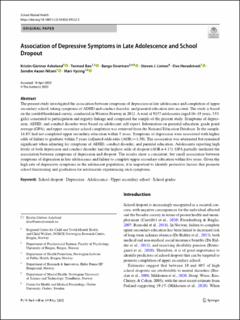| dc.contributor.author | Askeland, Kristin Gärtner | |
| dc.contributor.author | Bøe, Tormod | |
| dc.contributor.author | Sivertsen, Børge | |
| dc.contributor.author | Linton, Steven J. | |
| dc.contributor.author | Heradstveit, Ove | |
| dc.contributor.author | Nilsen, Sondre Aasen | |
| dc.contributor.author | Hysing, Mari | |
| dc.date.accessioned | 2023-01-25T10:38:39Z | |
| dc.date.available | 2023-01-25T10:38:39Z | |
| dc.date.created | 2022-09-30T13:08:04Z | |
| dc.date.issued | 2022 | |
| dc.identifier.citation | School Mental Health. 2022, . | |
| dc.identifier.issn | 1866-2625 | |
| dc.identifier.uri | https://hdl.handle.net/11250/3046201 | |
| dc.description.abstract | The present study investigated the association between symptoms of depression in late adolescence and completion of upper secondary school, taking symptoms of ADHD and conduct disorder, and parental education into account. The study is based on the youth@hordaland-survey, conducted in Western Norway in 2012. A total of 9157 adolescents (aged 16–19 years, 53% girls) consented to participation and registry linkage and comprised the sample of the present study. Symptoms of depression, ADHD, and conduct disorder were based on adolescent self-report. Information on parental education, grade point average (GPA), and upper secondary school completion was retrieved from the National Education Database. In the sample, 14.8% had not completed upper secondary education within 5 years. Symptoms of depression were associated with higher odds of failure to graduate within 5 years (adjusted odds ratio (AOR) = 1.50). The association was attenuated but remained significant when adjusting for symptoms of ADHD, conduct disorder, and parental education. Adolescents reporting high levels of both depression and conduct disorder had the highest odds of dropout (AOR = 4.15). GPA partially mediated the association between symptoms of depression and dropout. The results show a consistent, but small association between symptoms of depression in late adolescence and failure to complete upper secondary education within five years. Given the high rate of depressive symptoms in the adolescent population, it is important to identify protective factors that promote school functioning and graduation for adolescents experiencing such symptoms. | |
| dc.description.abstract | Association of Depressive Symptoms in Late Adolescence and School Dropout | |
| dc.language.iso | eng | |
| dc.title | Association of Depressive Symptoms in Late Adolescence and School Dropout | |
| dc.title.alternative | Association of Depressive Symptoms in Late Adolescence and School Dropout | |
| dc.type | Peer reviewed | |
| dc.type | Journal article | |
| dc.description.version | publishedVersion | |
| dc.source.pagenumber | 13 | |
| dc.source.journal | School Mental Health | |
| dc.identifier.doi | 10.1007/s12310-022-09522-5 | |
| dc.identifier.cristin | 2057209 | |
| dc.relation.project | Stiftelsen Dam: 2018/FO202170 | |
| cristin.ispublished | true | |
| cristin.fulltext | original | |
| cristin.qualitycode | 1 | |
